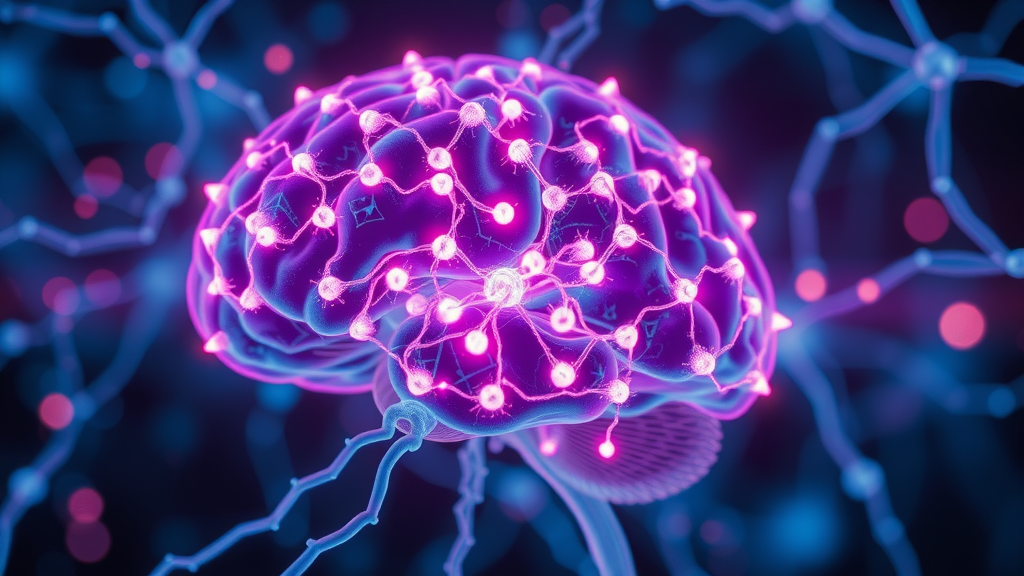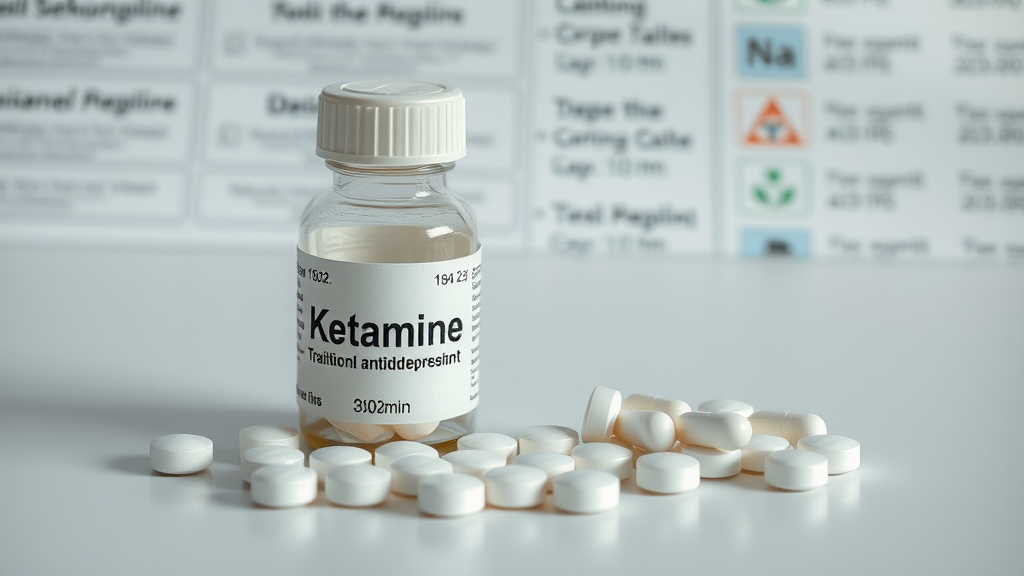Over 30% of depression patients don’t respond to traditional treatments. If you are among them, hope is not lost—there’s a groundbreaking option that might finally bring the relief you deserve. Ketamine therapy has transformed the landscape of mental health by providing rapid and effective treatment for those suffering from resistant depression, stress disorders, and even suicidal ideation. Dive in to discover how this innovative treatment option could fast-track your journey to mental wellness.

Over 30% of Depression Patients Don’t Respond to Traditional Treatments—Here’s How Ketamine Therapy Can Help
When it feels like nothing works, the idea of another medication or therapy can be daunting. Ketamine therapy stands out because it works on brain pathways differently than standard antidepressants. Instead of waiting weeks or months to notice any improvement, many patients report dramatic relief from depression symptoms within 24-72 hours after receiving ketamine . For patients with resistant depression who have tried multiple medications and therapies without success, this rapid response is revolutionary.
Recent years have seen significant expansion in ketamine clinics across the country as more clinical evidence highlights its effectiveness in treating a range of mental health conditions , including stress disorder and suicidal ideation . Whether as an IV ketamine infusion or intranasal esketamine nasal spray , this method disrupts the cycle of relentless low mood in ways no other medication can. For anyone struggling with persistent symptoms, ketamine therapy offers new hope, supported by a growing body of research and real-world success stories.
How Ketamine Therapy Works for Mental Health and Resistant Depression
What is Ketamine Therapy? Unpacking a Revolutionary Treatment Option
Ketamine therapy involves administering a low dose of ketamine to alleviate symptoms of various psychiatric disorders, most notably resistant depression . Originally developed as an anesthetic, ketamine’s antidepressant effects were discovered serendipitously in clinical settings. The therapy can be delivered through several methods, including IV ketamine infusions, intranasal esketamine (an FDA-approved nasal spray), and tailored at-home protocols. Unlike traditional antidepressants that target neurotransmitters like serotonin, ketamine works by rapidly promoting neuroplasticity—transforming how the brain responds to stress and distressing thoughts.
This unique mechanism of action helps restore balance to overactive neural circuits associated with depression. By doing so, ketamine therapy offers a fast-acting alternative for people whose conditions didn’t improve with standard medications. Each treatment plan is customized to individual needs, considering the optimal dose of ketamine and delivery method, making it a truly personalized treatment option for mental health .
For those interested in a holistic approach to mental wellness, combining ketamine therapy with other evidence-based modalities can further enhance outcomes. Exploring seasonal strategies for mental health, such as those discussed in Spring Renewal for Your Mind , may provide additional support and resilience during your recovery journey.

Ketamine Therapy in Mental Health: A Breakthrough for Resistant Depression
For many with resistant depression , standard therapies just don’t cut it. This is where ketamine for depression turns the tables. Unlike other medications that can take weeks to take effect, ketamine rapidly acts on the NMDA receptors in the brain, triggering a cascade of changes that support rapid mood improvement. Patients often report a reduction in depressive symptoms after the very first session, which is why ketamine infusions are especially valuable for those battling severe or long-lasting depression.
Beyond depression, this treatment is also showing promise in treating stress disorder and suicidal ideation . It’s important to note, however, that the therapy’s success is maximized when administered in a controlled environment such as a reputable ketamine clinic . Here, the safety and efficacy of each session are closely monitored by medical professionals, ensuring that the right dose of ketamine is delivered safely, with minimal risk of side effects.
Why Choose a Ketamine Clinic? Experience, Safety, and Outcomes

What Happens at a Ketamine Clinic: From Consultation to Treatment
A ketamine clinic offers more than just medication—it’s a center where expertise, safety, and compassion come together to offer the best mental health outcomes. The process typically begins with a thorough consultation where your psychiatric and medical histories are assessed to ensure ketamine therapy is appropriate and safe for your health condition. If you are a good candidate, a tailored treatment plan is developed, pairing the right doses of ketamine with proper monitoring protocols.
At each appointment, you’ll experience a welcoming environment designed to maximize comfort and calm. The highly trained team closely monitors vital signs, such as blood pressure and heart rate, to promptly address any concerns. These clinics also provide aftercare and support, helping with integration and long-term recovery after the initial series of treatments. With qualified medical oversight, patients can trust they are receiving ketamine that is both effective and safe.
Ketamine Infusion vs. Intranasal Esketamine: Comparing Delivery Methods for Ketamine Therapy
With advancing research, two primary delivery methods for ketamine therapy have emerged: IV ketamine infusions and intranasal esketamine . Ketamine infusion involves administering the medication intravenously over 40-60 minutes, allowing precise control over drug administration and immediate monitoring. This method is often chosen for patients with severe or long-standing psychiatric disorders and offers flexibility in adjusting the dose for personalized needs.
Intranasal esketamine , branded as Spravato, is an FDA-approved nasal spray designed specifically for resistant depression . This nasal spray formulation allows for easier outpatient administration and eliminates the need for an IV, offering a practical alternative for those who prefer less invasive treatments. While both routes are effective, reviewing the benefits and limitations of each with your clinic’s team ensures the treatment aligns closely with your mental health goals.
The Benefits of Ketamine Therapy: Speed, Effectiveness, and Hope
- Rapid relief from depressive symptoms, often within hours or days
- Proven to be effective for resistant depression when other treatments have failed
- Improves outcomes for anxiety , stress disorder , and suicidal ideation
- Multiple delivery options for different patient needs
- Safe and well-monitored environment in a certified ketamine clinic
| Feature | Traditional Antidepressants | Ketamine Therapy |
|---|---|---|
| Onset of Action | 2-8 weeks for effects Delayed symptom improvement |
Hours to days for effects Rapid symptom improvement |
| Efficacy (for resistant cases) | Limited (30% non-response) | High, especially for resistant depression |
| Side Effects | Weight gain, sexual dysfunction, GI upset | Short-term: mild dissociation, elevated blood pressure, nausea |
| Administration | Daily oral medication | Clinic-based IV infusion or intranasal spray |
Navigating Side Effects: What You Need to Know Before Starting Ketamine Treatment

Common Side Effects of Ketamine Therapy
Like any treatment option , ketamine therapy can have side effects. Thankfully, most are short-lived and mild. The most common side effects include mild dissociation or a sense of detachment, dizziness, mild increases in blood pressure, and nausea. Some patients may briefly experience blurred vision or perceptual changes, but these usually resolve within an hour after the session.
Unlike the persistent effects of ketamine some medications can cause, the effects of ketamine are closely monitored in the clinic setting. Medical professionals will adjust the dose of ketamine as needed, mitigating risks and ensuring patient safety. Most people return to normal activities soon after, although it is recommended to have someone drive you home after your session.
Managing Risks: Who Should Consider Ketamine Infusions or Intranasal Esketamine?
Safety and efficacy are at the heart of every ketamine clinic . Ideal candidates for ketamine infusions or intranasal esketamine typically have a documented history of resistant depression or other psychiatric disorders unresponsive to standard therapies. Those with uncontrolled hypertension, a history of substance use disorder, or certain neurological health conditions may not be suitable for this therapy.
Honest consultation with your provider is essential. Disclose all health conditions and medications to ensure the recommended dose of ketamine is right for you. By partnering with a certified clinic, you get a comprehensive assessment and personalized plan to achieve genuine mental health improvement while managing potential risks.
“Ketamine therapy has changed the course of mental health treatment, offering rapid relief where all else has failed.” – Psychiatric Expert
Ketamine Treatment Options: Infusions, Intranasal Esketamine, and At-Home Protocols
Ketamine Infusion: What to Expect During a Session
If you’re considering ketamine infusion , rest assured it’s a straightforward process. Upon arrival at the clinic, you’ll be seated comfortably, and your vitals will be recorded. An IV line will be placed, and the ketamine treatment will begin, typically lasting 40-60 minutes. Trained staff monitor your experience the entire time, ensuring comfort and addressing any side effects like nausea or elevated blood pressure immediately.
Many patients describe sensations of calm or slight detachment during the session. Most return to feeling themselves within an hour. This iv ketamine delivery provides highly controlled dosing, making it a reliable choice for treating severe mental health concerns, stress disorders, and suicidal ideation.

Intranasal Esketamine: FDA-Approved Route for Resistant Depression
Intranasal esketamine is a nasal spray treatment approved by the Food and Drug Administration for adults with resistant depression . Administered under clinical supervision, this option requires no needles and offers rapid, effective antidepressant effects by delivering the medication through nasal mucosa directly to the brain. Sessions are short, often completed within two hours, including monitoring for any immediate side effects such as mild dissociation or increased blood pressure.
The convenience and safety of this nasal spray make it popular among patients who want less invasive, outpatient solutions. Consultations with your ketamine clinic can help you decide if intranasal esketamine best matches your mental health needs.
Is Ketamine Therapy Right for You? Assessing Mental Health Conditions, Stress Disorder, and Suicidal Ideation
- Depression (especially resistant depression )
- Anxiety and stress disorder
- Bipolar disorder
- Suicidal ideation
- Post-traumatic stress disorder (PTSD)
- Obsessive-compulsive disorder (OCD)
- Other chronic mental health and psychiatric disorders unresponsive to standard therapies
People Also Ask
How quickly does ketamine therapy work for depression?
Most patients report noticeable relief from depressive symptoms within hours to a few days after their ketamine infusion or intranasal esketamine session. This fast-acting effect is a major advantage over traditional antidepressants, which may take weeks to provide benefits. The speed of response can be life-changing for those struggling with severe resistant depression or acute suicidal ideation.
Is ketamine therapy safe for long-term use?
When administered in a controlled clinical setting, ketamine therapy is generally safe for most patients. Clinics maintain strict monitoring protocols to minimize adverse effects, and patients undergo comprehensive health screenings before beginning therapy. Ongoing research continues on long-term safety, but repeated, medically-guided treatments have shown few significant risks for most individuals.
Can ketamine treatment help if other antidepressants failed?
Yes, that’s one of the defining strengths of ketamine therapy . For patients who have not experienced relief with standard antidepressants and therapies, ketamine offers a novel approach that targets depression through different brain pathways. Clinical studies and real-world experiences show high response rates, particularly for serious or resistant cases.
What are the side effects of ketamine infusion versus other treatments?
Ketamine infusions may produce short-term side effects like mild dissociation, increased blood pressure, dizziness, or nausea, most of which resolve quickly after treatment. Compared to longer-term side effects associated with traditional antidepressants—such as weight gain or sexual dysfunction—ketamine’s side effects are typically mild, transient, and closely managed in a medical setting.

How is intranasal esketamine different from ketamine infusion?
Intranasal esketamine is a nasal spray approved by the Food and Drug Administration specifically for treatment-resistant depression, while ketamine infusion delivers the drug intravenously. Both options offer rapid antidepressant effects but differ in their routes of drug administration and session protocol. Consultation with your mental health provider will help determine the most suitable approach for your needs.
Frequently Asked Questions about Ketamine Therapy
What makes ketamine therapy unique in mental health treatment?
Ketamine therapy is unique due to its rapid onset, ability to address resistant forms of depression and other mental health conditions, and its mechanism of enhancing brain neuroplasticity. It delivers hope for patients who haven’t responded to other medications, allowing them to regain a sense of control and wellbeing faster than traditional options.
Is ketamine therapy covered by insurance?
Coverage for ketamine therapy varies between insurance providers and plans. Some insurance may cover intranasal esketamine (Spravato) treatments for treatment-resistant depression, while IV ketamine infusions are less commonly covered. It’s best to check with your provider and the ketamine clinic about insurance options and payment plans.
Where can I find a trusted ketamine clinic near me?
Look for certified ketamine clinics with experienced providers specializing in mental health and ketamine treatment. These clinics conduct comprehensive assessments, provide evidence-based care, and closely monitor every session to ensure safety and effectiveness. Use trusted online directories or consult your mental health professional for a referral.
What is the cost of ketamine treatment for resistant depression?
Costs can range from $400 to $800 per ketamine infusion , with an initial series usually recommended. Intranasal esketamine pricing may differ, especially when factoring in insurance. Many clinics offer payment options or package pricing for extended treatment courses—consult your chosen clinic for exact costs and available financial support.
Your Fast Track to Relief: Begin Ketamine Therapy Now
“Our mission is to restore hope through innovative mental health solutions like ketamine therapy.”
Key Takeaways: Why Ketamine Therapy Is Transforming Depression Treatment
- Ketamine therapy offers rapid relief for resistant depression.
- Safe and effective when administered at certified ketamine clinics.
- Multiple delivery options: infusion, intranasal esketamine, at-home protocols.
- Improves outcomes for mental health conditions, including major depression and stress disorder.
Ready to Take the Next Step Toward Mental Wellness?
Let’s talk—your first step starts here → https://brainmindwellness.com/calendars/
Take action now—schedule a consultation with a reputable ketamine clinic and experience a proven, transformative step toward fast depression relief and sustainable mental wellness.
As you consider your options for overcoming resistant depression, remember that innovative therapies like ketamine are just one part of a broader mental health journey. For those seeking to deepen their understanding or explore additional strategies for emotional resilience, the Brain Mind Wellness resource hub offers a wealth of insights on holistic mental health, self-improvement, and the latest in neuroscience-backed care. Whether you’re ready to take the next step or simply want to expand your knowledge, exploring these resources can empower you to make informed, confident decisions for your wellbeing. Your path to lasting mental wellness is unique—discover more ways to support it today.
For those exploring innovative treatments for depression, understanding the nuances of ketamine therapy is crucial. The article “Ketamine Therapy: How It Works, Types, Benefits, and Side Effects” provides a comprehensive overview of the various administration methods, including intravenous infusions and intranasal sprays, detailing their respective benefits and potential side effects. ( tikkunhealingcenter.org ) Additionally, “Ketamine for treatment-resistant depression: When and where is it safe?” offers valuable insights into the safety considerations and appropriate settings for ketamine therapy, emphasizing the importance of professional supervision and patient selection criteria. ( health.harvard.edu ) If you’re serious about exploring ketamine therapy as a treatment option, these resources will equip you with essential information to make informed decisions.
 Add Row
Add Row  Add
Add 



Write A Comment